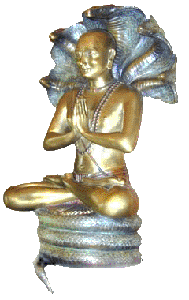Prana is life. It is the energy of the universe. Prana is also often considered to be our breath. In Latin, the word “spiritus” also means breath. When our breath leaves us, it is the same as our spirit departing. Pranayama is a freeing of the breath, of the spirit.
The word pranayama is really two Sanskrit words: prana and ayama. This is often misunderstood, and many students think the two words are prana and yama. Yama means to restrain or control, ayama is to not do that. Thus in a pranayama practice we are trying to free up the energy of prana, not restrain it. This can be confusing as many teachers and authors prefer to interpret pranayama as controlling the breath. Perhaps a better way to think of pranayama is to consider it regulating the breath, but in such a way that the prana is actually freed or extended in a controlled way.
Why would we want to regulate the breath? Consider this analogy: the mind and the breath are like two fish in a school; when one fish moves the other moves with it. If you have ever attempted to meditate and still the turnings of your mind, you know how difficult this is. Zen is one discipline that attempts to still the mind through sheer willpower. This is a most difficult way and it is not surprising that Zen was a practice of the samurai; it is a hard practice and not for everyone. Yoga sought an easier route to the same goal, through regulating the breath. If the breath is quiet, the mind is still. If you really pay attention, you may discover that the moments between breaths are the moments between thoughts.
Almost two thousand years ago an important book was written: the Yoga Sutra. Myths abound about the author of this sutra, and a thousand years after its compilation people began to say that the author was a sage named Patanjali. We may never know who wrote the sutra, but that doesn’t stop it from being an excellent source of knowledge on Classical Yoga. Like all ancient texts, it was never meant to be used as a standalone teaching. A guru’s knowledge is required to really understand the sutra. Perhaps we should consider the Yoga Sutra a sort of “Coles Notes” condensation of a guru’s teaching. [1]

In the Yoga Sutra, the aim of Classical Yoga was given in the second line: Yogas-citta-vritti-nirodhah; Yoga is the stilling of the fluctuations of the mind-stuff. Within the sutra are given many methods for accomplishing this rather daunting task. Pranayama is the fourth stage of an eight-limbed method offered in this sutra. [2]
According to the Yoga Sutra, [3] the practice of pranayama should be dirgha (extended) and sukshma (subtle). This means the practice should allow the breath to become long without being forced. The sutra then describes the four components of the breath and the three phases of pranayama. The four components are:
- Placement – where are you putting the breath?
- Time – how long is your breath?
- Number – how many repetitions are you doing?
- Intensity – how much force are you exerting?
The three phases of the breath are
- Inhalation called puraka
- Exhalation called rechaka
- Retention called kumbhaka or holding of the breath either between the inhalation and exhalation (antara kumbhaka) or between the exhalation and inhalation (bahya kumbhaka).
When the breath is extended and the practice is mature, then a fourth phase of the breath arises: kevala. Kevala means isolated. In this state the breath naturally suspends itself, without any effort or force. Later sages explained that in this stage, the kundalini awakens and thus the prana is freed.
Almost every sage from Patanjali onward noted that pranayama was more valuable than the practice of asana. Asana is a preparatory stage, allowing the body to be strong and healthy enough to engage in pranayama. In the same way, pranayama can be considered just one step on the path toward the practices of meditation. When the breath is regulated, the mind can be approached; insight becomes possible.
All yoga involves the breath; how can it not? All life involves breathing. And so, even in our asana practice, the breath is present, providing us the opportunity to regulate it. Yin Yoga is no different. We are given the opportunity to free and extend the breath. Regulating the breath, however, is not the only way to stimulate the flow of prana. Pranayama is just one method. Other methods include massaging the body, directing our awareness, being in the presence of others, and yes even the performance of asanas. How we can stimulate prana to flow as part of our Yin Yoga practice is discussed in Chapter 15: Moving Energy.
- — For our American readers, consider the Yoga Sutra as the “Cliffs Notes” of Classical Yoga.
- — People have taken to calling these eight limbs the ashtanga; however, the author of the Yoga Sutra never used this term.
- — Yoga Sutra, II-50.
(Next: The Daoist View of Energy )
